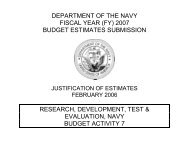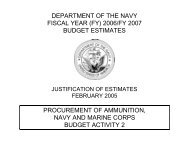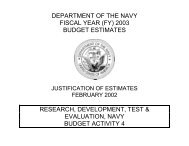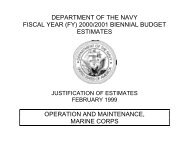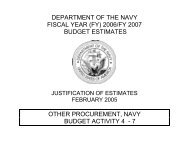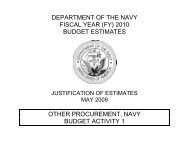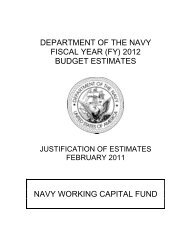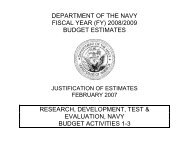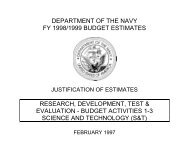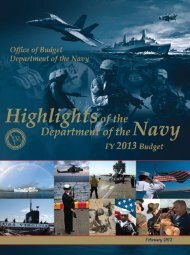Budget Highlights Book - DON FM&C Website - U.S. Navy
Budget Highlights Book - DON FM&C Website - U.S. Navy
Budget Highlights Book - DON FM&C Website - U.S. Navy
You also want an ePaper? Increase the reach of your titles
YUMPU automatically turns print PDFs into web optimized ePapers that Google loves.
February 2010Integrating Sustained Support for Warfighting Needsmore remote geographic location of the combat region and greater personnelrequirements in country.Participation will consist of approximately 20,000 Marines conductingcounterinsurgency, security cooperation, and civil‐military operations in Iraq andAfghanistan. On any given day there are approximately 12,300 Sailors ashore andanother 9,800 afloat throughout the U.S. Central Command region conductingriverine operations, maritime infrastructure protection, explosive ordnance disposal,combat construction engineering, cargo handling, combat logistics, maritimesecurity, and other forward presence activities. In collaboration with the U.S. CoastGuard, the <strong>Navy</strong> also conducts critical port operations, port and oil platformsecurity, and maritime interception operations. Included in our globally sourcedforces are 15,600 IAs serving in a variety of joint or coalition billets, either in thetraining pipeline or on station. As these operations unfold, the size and type ofnaval forces committed to them will likely evolve, thereby producing changes to theoverall force posture of naval forces. Long after the significant land componentpresence is reduced, naval forces will remain forward.While forward, acting as the lead elementof our defense‐in‐depth, naval forces willbe positioned for increased roles incombating terrorism. They will also beprepared to act in cooperation with anexpanding set of international partners toprovide humanitarian assistance anddisaster response, as well as contribute toglobal maritime security. ExpandedMaritime Interdiction Operations (EMIO)are authorized by the President and directed by the Secretary of Defense to interceptvessels identified to be transporting terrorists and/or terrorist‐related materiel thatposes an imminent threat to the United States and its alliesStrike operations are conducted to damage or destroy objectives or selected enemycapabilities. Recent examples include simultaneous close air support missions thatare integrated and synchronized with coalition ground forces to protect keyinfrastructure, deter and disrupt extremist operations or hostile activities, andprovide oversight for reconstruction efforts in support of Operations EnduringFreedom and Iraqi Freedom. They have also included small, precise attacks againstterrorist cells, missile attacks against extremist sanctuaries, and the April 2009 rescue2‐2 FY 2011 Department of the <strong>Navy</strong> <strong>Budget</strong>



